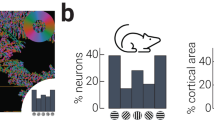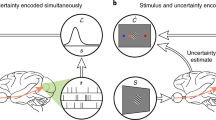Abstract
Extensive training on simple tasks such as fine orientation discrimination results in large improvements in performance, a form of learning known as perceptual learning. Previous models have argued that perceptual learning is due to either sharpening and amplification of tuning curves in early visual areas or to improved probabilistic inference in later visual areas (at the decision stage). However, early theories are inconsistent with the conclusions of psychophysical experiments manipulating external noise, whereas late theories cannot explain the changes in neural responses that have been reported in cortical areas V1 and V4. Here we show that we can capture both the neurophysiological and behavioral aspects of perceptual learning by altering only the feedforward connectivity in a recurrent network of spiking neurons so as to improve probabilistic inference in early visual areas. The resulting network shows modest changes in tuning curves, in line with neurophysiological reports, along with a marked reduction in the amplitude of pairwise noise correlations.
This is a preview of subscription content, access via your institution
Access options
Subscribe to this journal
Receive 12 print issues and online access
$209.00 per year
only $17.42 per issue
Buy this article
- Purchase on Springer Link
- Instant access to full article PDF
Prices may be subject to local taxes which are calculated during checkout







Similar content being viewed by others
References
Ramachandran, V.S. & Braddick, O. Orientation-specific learning in stereopsis. Perception 2, 371–376 (1973).
Fahle, M., Edelman, S. & Poggio, T. Fast perceptual learning in hyperacuity. Vision Res. 35, 3003–3013 (1995).
Fiorentini, A. & Berardi, N. Perceptual learning specific for orientation and spatial frequency. Nature 287, 43–44 (1980).
Dosher, B.A. & Lu, Z.L. Mechanisms of perceptual learning. Vision Res. 39, 3197–3221 (1999).
Fine, I. & Jacobs, R.A. Comparing perceptual learning tasks: A review. J. Vis. 2, 190–203 (2002).
Recanzone, G.H., Merzenich, M.M., Jenkins, W.M., Grajski, K.A. & Dinse, H.R. Topographic reorganization of the hand representation in cortical area 3b owl monkeys trained in a frequency-discrimination task. J. Neurophysiol. 67, 1031–1056 (1992).
Recanzone, G.H., Schreiner, C.E. & Merzenich, M.M. Plasticity in the frequency representation of primary auditory cortex following discrimination training in adult owl monkeys. J. Neurosci. 13, 87–103 (1993).
Schoups, A., Vogels, R., Qian, N. & Orban, G. Practising orientation identification improves orientation coding in V1 neurons. Nature 412, 549–553 (2001).
Yang, T. & Maunsell, J.H.R. The effect of perceptual learning on neuronal responses in monkey visual area V4. J. Neurosci. 24, 1617–1626 (2004).
Ahissar, M. & Hochstein, S. Task difficulty and the specificity of perceptual learning. Nature 387, 401–406 (1997).
Fahle, M. & Morgan, M. No transfer of perceptual learning between similar stimuli in the same retinal position. Curr. Biol. 6, 292–297 (1996).
Karni, A. & Sagi, D. Where practice makes perfect in texture discrimination: evidence for primary visual cortex plasticity. Proc. Natl. Acad. Sci. USA 88, 4966–4970 (1991).
Xiao, L.Q. et al. Complete transfer of perceptual learning across retinal locations enabled by double training. Curr. Biol. 18, 1922–1926 (2008).
Zhang, J.-Y. et al. Rule-based learning explains visual perceptual learning and its specificity and transfer. J. Neurosci. 30, 12323–12328 (2010).
Watanabe, T. et al. Greater plasticity in lower-level than higher-level visual motion processing in a passive perceptual learning task. Nat. Neurosci. 5, 1003–1009 (2002).
Raiguel, S., Vogels, R., Mysore, S.G. & Orban, G.A. Learning to see the difference specifically alters the most informative V4 neurons. J. Neurosci. 26, 6589–6602 (2006).
Schwabe, L. & Obermayer, K. Adaptivity of tuning functions in a generic recurrent network model of a cortical hypercolumn. J. Neurosci. 25, 3323–3332 (2005).
Teich, A.F. & Qian, N. Learning and adaptation in a recurrent model of V1 orientation selectivity. J. Neurophysiol. 89, 2086–2100 (2003).
Averbeck, B.B., Latham, P.E. & Pouget, A. Neural correlations, population coding and computation. Nat. Rev. Neurosci. 7, 358–366 (2006).
Cohen, M.R. & Maunsell, J.H.R. Attention improves performance primarily by reducing interneuronal correlations. Nat. Neurosci. 12, 1594–1600 (2009).
Zohary, E., Shadlen, M.N. & Newsome, W.T. Correlated neuronal discharge rate and its implications for psychophysical performance. Nature 370, 140–143 (1994).
Seriès, P., Latham, P.E. & Pouget, A. Tuning curve sharpening for orientation selectivity: coding efficiency and the impact of correlations. Nat. Neurosci. 7, 1129–1135 (2004).
Spiridon, M. & Gerstner, W. Effect of lateral connections on the accuracy of the population code for a network of spiking neurons. Network 12, 409–421 (2001).
Levi, D.M. & Klein, S.A. Noise provides some new signals about the spatial vision of amblyopes. J. Neurosci. 23, 2522–2526 (2003).
Gold, J., Bennett, P.J. & Sekuler, A.B. Signal but not noise changes with perceptual learning. Nature 402, 176–178 (1999).
Li, R.W., Levi, D.M. & Klein, S.A. Perceptual learning improves efficiency by re-tuning the decision 'template' for position discrimination. Nat. Neurosci. 7, 178–183 (2004).
Dosher, B.A. & Lu, Z.L. Perceptual learning reflects external noise filtering and internal noise reduction through channel reweighting. Proc. Natl. Acad. Sci. USA 95, 13988–13993 (1998).
Petrov, A.A., Dosher, B.A. & Lu, Z.L. The dynamics of perceptual learning: an incremental reweighting model. Psychol. Rev. 112, 715–743 (2005).
Lu, Z.-L., Liu, J. & Dosher, B.A. Modeling mechanisms of perceptual learning with augmented Hebbian re-weighting. Vision Res. 50, 375–390 (2010).
Law, C.-T. & Gold, J.I. Neural correlates of perceptual learning in a sensory-motor, but not a sensory, cortical area. Nat. Neurosci. 11, 505–513 (2008).
Law, C.-T. & Gold, J.I. Reinforcement learning can account for associative and perceptual learning on a visual-decision task. Nat. Neurosci. 12, 655–663 (2009).
Tolhurst, D.J., Movshon, J.A. & Dean, A.F. The statistical reliability of signals in single neurons in cat and monkey visual cortex. Vision Res. 23, 775–785 (1983).
Somers, D.C., Nelson, S.B. & Sur, M. An emergent model of orientation selectivity in cat visual cortical simple cells. J. Neurosci. 15, 5448–5465 (1995).
Ferster, D. & Miller, K.D. Neural mechanisms of orientation selectivity in the visual cortex. Annu. Rev. Neurosci. 23, 441–471 (2000).
Beck, J.M., Bejjanki, V.R. & Pouget, A. Insights from a simple expression for linear Fisher information in a recurrently connected population of spiking neurons. Neural Comput. (in the press).
Ghose, G.M., Yang, T. & Maunsell, J.H.R. Physiological correlates of perceptual learning in monkey V1 and V2. J. Neurophysiol. 87, 1867–1888 (2002).
Gutnisky, D.A. & Dragoi, V. Adaptive coding of visual information in neural populations. Nature 452, 220–224 (2008).
Smith, M.A. & Kohn, A. Spatial and temporal scales of neuronal correlation in primary visual cortex. J. Neurosci. 28, 12591–12603 (2008).
Montani, F., Kohn, A., Smith, M.A. & Schultz, S.R. The role of correlations in direction and contrast coding in the primary visual cortex. J. Neurosci. 27, 2338–2348 (2007).
Jacobs, R.A. Adaptive precision pooling of model neuron activities predicts the efficiency of human visual learning. J. Vis. 9, 22 (2009).
Beck, J.M. et al. Probabilistic population codes for Bayesian decision making. Neuron 60, 1142–1152 (2008).
Gold, J.I. & Shadlen, M.N. Neural computations that underlie decisions about sensory stimuli. Trends Cogn. Sci. 5, 10–16 (2001).
Ma, W.J., Beck, J.M., Latham, P.E. & Pouget, A. Bayesian inference with probabilistic population codes. Nat. Neurosci. 9, 1432–1438 (2006).
Simoncelli, E.P., Adelson, E.H. & Heeger, D.J. Probability distributions of optical flow. in IEEE Conference on Computer Vision and Pattern Recognition 310–315 (1991).
Hua, T. et al. Perceptual learning improves contrast sensitivity of V1 neurons in cats. Curr. Biol. 20, 887–894 (2010).
Pouget, A., Deneve, S. & Latham, P.E. The relevance of Fisher information for theories of cortical computation and attention. in Visual Attention and Cortical Circuits (eds. Braun, J., Koch, C. & Davis, J.L.) (2001).
Spitzer, H., Desimone, R. & Moran, J. Increased attention enhances both behavioral and neuronal performance. Science 240, 338–340 (1988).
Treue, S. & Maunsell, J.H.R. Attentional modulation of visual motion processing in cortical areas MT and MST. Nature 382, 539–541 (1996).
Gerstner, W. & Kistler, W. Spiking Neuron Models: An Introduction (Cambridge Univ. Press, New York, 2002).
Wu, S., Nakahara, H. & Amari, S.I. Population coding with correlation and an unfaithful model. Neural Comput. 13, 775–797 (2001).
Acknowledgements
J.M.B. was supported by the Gatsby Charitable Foundation. Z.-L.L. is supported by US National Eye Institute grant 9 R01 EY017491-05 and A.P. by Multidisciplinary University Research Initiative grant N00014-07-1-0937, US National Institute on Drug Abuse grant BCS0346785 and a research grant from the James S. McDonnell Foundation. This work was also partially supported by award P30 EY001319 from the US National Eye Institute.
Author information
Authors and Affiliations
Contributions
V.R.B. conceived the project, built the network model, ran all the simulations and analyses and wrote the paper. J.M.B. developed the analytic derivations, helped with building the network model and wrote the paper. Z.-L.L. worked on the link between the neural model and TVC curves and helped with parameter tuning. A.P. conceived the project, supervised the simulations and analyses and wrote the paper.
Corresponding author
Ethics declarations
Competing interests
The authors declare no competing financial interests.
Supplementary information
Supplementary Text and Figures
Supplementary Figures 1 and 2, Supplementary Tables 1 and 2, Supplementary Note (PDF 322 kb)
Rights and permissions
About this article
Cite this article
Bejjanki, V., Beck, J., Lu, ZL. et al. Perceptual learning as improved probabilistic inference in early sensory areas. Nat Neurosci 14, 642–648 (2011). https://doi.org/10.1038/nn.2796
Received:
Accepted:
Published:
Issue Date:
DOI: https://doi.org/10.1038/nn.2796
This article is cited by
-
Monocular perceptual learning of contrast detection facilitates binocular combination in adults with anisometropic amblyopia
Scientific Reports (2016)
-
A review of the mechanisms by which attentional feedback shapes visual selectivity
Brain Structure and Function (2015)
-
Perceptual training continuously refines neuronal population codes in primary visual cortex
Nature Neuroscience (2014)
-
Fast transfer of crossmodal time interval training
Experimental Brain Research (2014)
-
Decoding spiking activity in V4, but not V1, correlates with behavioural performance in perceptual learning task
BMC Neuroscience (2013)



